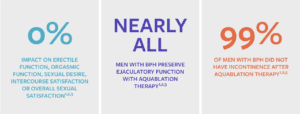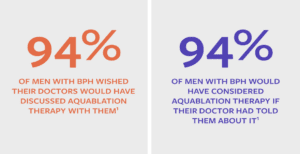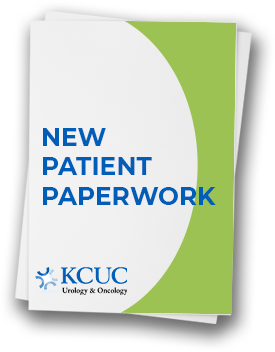Aquablation therapy is a new type of surgical treatment for benign prostatic hyperplasia (BPH). At KCUC, we are proud to be the first in Kansas City Metropolitan area to offer this advanced, minimally invasive treatment.
We are excited to offer Aquablation therapy at North Kansas City Hospital and Advent Health South Overland Park, because we believe in helping men suffering from BPH to get their life back and feel like themselves again.
We know choosing a treatment option can be overwhelming, as it often forces men to compromise in some way. This could mean not responding well to medication, or choosing a treatment that only provides limited relief, that may have a long recovery time, or that may even cause issues with sexual function.
Aquablation therapy is a one-of-a-kind procedure that aims to minimize this compromise.

What is Aquablation Therapy?
Aquablation therapy is performed by the AquaBeam Robotic System, the first FDA-cleared, surgical robot utilizing automated tissue resection for the treatment of LUTS due to BPH. Aquablation uses the power of water delivered with robotic precision to provide long-lasting BPH relief without compromise. It is precise, consistent, and predictable, and provides long-term relief no matter how large the prostate.2,3
Ed’s Story:
How does Aquablation Therapy work?
Aquablation therapy is a resective procedure, which means that the prostate tissue causing symptoms is surgically removed. No incision is made in the abdomen, as the prostate is reached through the urethra.
Aquablation therapy is performed in a hospital and is done under anesthesia. The procedure typically takes less than an hour and may involve an overnight stay.
There are two key steps to the Aquablation procedure:
Step 1. Creating a Surgical Map
Every prostate is unique in size and shape. Aquablation therapy enables our surgeons to customize your procedure to your specific anatomy.
Aquablation therapy is the only BPH surgical procedure which integrates ultrasound imaging with the standard camera (called a cystoscope). This gives our surgeons the ability to see the entire prostate in real time, which allows our surgeons to map which parts of your prostate they want to remove and which parts they want to avoid. Specifically, this mapping enables our surgeons to avoid removing the parts of the prostate that cause irreversible complications like erectile dysfunction, ejaculatory dysfunction, and incontinence.
Step 2. Removing the Prostate Tissue
Once our surgeons have created a surgical map, a robotically controlled, heat-free waterjet removes the prostate tissue that was outlined on the map. This robotic technology minimizes human error in removing prostate tissue, and ensures the prostate tissue is removed precisely, consistently, and predictably.
When required, our surgeons may choose to use a minimal amount of cautery following an Aquablation procedure to control bleeding.
What are the side effects of Aquablation therapy?
We know that the primary reason men are delaying surgery is because they are concerned about side effects.1 In fact, a recent survey shows that 85% of men are concerned that surgery will cause incontinence, and 4 out of 5 men are concerned that surgery will have a permanent impact on their sexual function.1
In clinical studies, men who had Aquablation therapy had a very low rate of irreversible complications—incontinence, ejaculatory dysfunction, erectile dysfunction.2,3

Is Aquablation therapy right for you?
Aquablation therapy is a different kind of surgical procedure. There are three reasons it may be right for you, but make sure to discuss with our surgeons to see if you’re a candidate.
1. Low Rates of Irreversible Complications
Aquablation therapy has a very low rates of irreversible complications (incontinence, ejaculatory dysfunction, erectile dysfunction)2,3,4 because:
- It is the only procedure that gives surgeons the ability to view the entire prostate so they can create a map that avoids the parts of the prostate that cause irreversible complications.
- It is the only procedure that uses a heat-free waterjet to remove prostate tissue. Technologies that use heat to remove prostate tissue may be damaging to the parts of the prostate that control erectile function and ejaculatory function. It should be noted that some surgeons may choose to use a minimal amount of cautery following an Aquablation procedure if it is required to control bleeding.
2. Confidence in Procedure
Aquablation therapy removes prostate tissue with a robotically controlled waterjet. This robotic technology minimizes human error and ensures the prostate tissue is removed precisely, consistently, and predictably.
3. Long-Term Relief
In clinical studies, Aquablation therapy has been shown to provide durable symptom relief.2
Take the International Prostate Symptom Score (IPSS) Quiz to measure how severe your symptoms are.
Take the Sexual Function Quiz to determine if maintaining sexual function after BPH surgery is important to you.

Aquablation Recovery
As with most BPH procedures, you will wake up with a catheter. Patients may need to stay overnight in the hospital. We may send you home with a catheter for a few days or may keep you an additional night in the hospital if you are unable to pee on your own or empty your bladder at the time of discharge.
We know that no one likes staying overnight in a hospital. However, the benefit with Aquablation therapy is that most patients end up leaving the hospital without a catheter.2,3,4
Once you are home, you may experience mild burning during urination for a couple of weeks. This can be managed with mild pain medication.
For more information, visit https://aquablation.com/safety-information/.
Have questions or want more information?
For more information, schedule an appointment at https://appointments.kcurology.com/, visit Aquablation.com for Frequently Asked Questions.
To stay up to date on all things related to Aquablation therapy, follow Aquablation therapy on Facebook and Twitter.
REFERENCES
- Data from a global survey of 300 patients with BPH. Data on file at PROCEPT BioRobotics.
- Gilling, P, et al. Three-Year Outcomes after Aquablation Therapy Compared to TURP: Results from a Blinded Randomized Trial. Can J Urol. 2020 Feb;27(1):10072-10079.
- Bhojani, N, et al. Aquablation for Benign Prostatic Hyperplasia in Large Prostates (80-150 cc): 1-Year Results. Urology. 2019 Jul;129:1-7.
- Data on file at PROCEPT BioRobotics.
INDICATIONS FOR USE
United States, Canada, Hong Kong – The AquaBeam® Robotic System is intended for the resection and removal of prostate tissue in males suffering from lower urinary tract symptoms due to benign prostatic hyperplasia.
Rest of World – The AquaBeam Robotic System is intended for the resection and removal of prostate tissue in males suffering from lower urinary tract symptoms.

